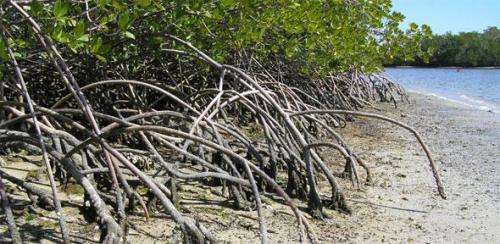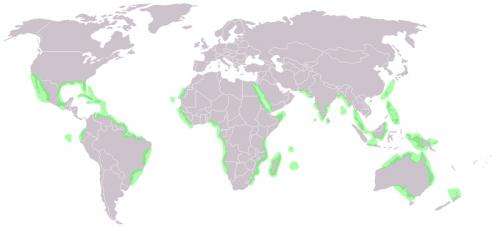Mangroves could survive sea-level rise if protected

Human activity is currently a bigger threat to mangroves, and the natural defences they provide against storm surges and other coastal disasters, than rising sea levels, according to a new study.
Mangroves, which provide a natural coastal defence to communities around the world, may be able to withstand a future rise in sea levels far more than previously thought, scientists have found.
Their report should serve to allay fears that many mangrove areas could be lost in the coming decades as sea levels go up because of global warming.
It comes, however, with a cautionary note: The authors, who have carried out a rare and detailed survey of how mangroves adapt to their environment, also argue that it is vital that they are managed and conserved so that they can continue to provide this protection.
The survey warns that human activity on land – such as the damming up of rivers or the felling of trees to create shrimp ponds – is currently a far greater threat to many mangrove habitats than the effects of climate change on sea level.
Mangroves – trees and shrubs which grow in saltwater, coastal environments – play a critical role in protecting thousands of shoreline communities in tropical and subtropical regions from floods, storms, and other hazards.
Their densely-packed, overground root systems can absorb wave energy and reduce the velocity of a sudden surge of water. In the 2004 tsunami, for example, mangroves were sometimes the difference between life and death for people whose homes lay in the path of the giant waves which crashed into shorelines around South Asia.

For some time, scientists have been concerned that if sea levels rise as predicted, they will kill off mangroves – removing these natural coastal defences at the very time they are expected to be needed most.
The new study suggests that this is far less likely than previously thought, however. Dr Anna McIvor, from the University of Cambridge, and the report's lead author, said: "Although we can expect some mangrove areas to be lost as sea levels rise, many of them appear to be able to withstand it."
"In fact, changes to mangrove habitats through human activity are likely to pose a bigger threat to these coastal defences than sea level rise as it stands. Our research has enabled us to find out more about how mangroves continue to flourish in spite of a rise in sea levels – but that information should be used as the basis for better management of these important ecosystems."
The study was carried out by a team from The Nature Conservancy, Wetlands International, and the Cambridge Coastal Research Unit (based in the University's Department of Geography). The researchers examined both recent reports looking at surface elevation in mangrove areas, and the historical reasons why mangroves have, in some places, persisted for thousands of years.
They found that the height of the soil surface in mangrove areas is often "surprisingly dynamic", and in some cases appears to be building up at rates of between one and 10 millimetres every year. The global mean sea level rise is currently 3mm per year, meaning that many mangrove areas build up soil at a rate which keeps pace with the sea.
There are several reasons for this, but chief among them appear to be the ability of mangroves to trap sediment as it is carried down to them by rivers, and the work of their roots beneath the surface. "Mangroves provide much of the organic sediment matter that makes up the soil, their complex roots help to bind and trap the sediments on the soil surface, while the unseen growth of roots beneath helps to build up the soil from below," McIvor said.
Despite this resistance to changes in sea level, however, the report cautions that the future stability of mangroves is by no means guaranteed. "Threshold rates of sea level rise are likely to exist, beyond which mangrove surfaces are no longer able to keep up," the authors point out.
Perhaps more urgently, in some regions human activities like agriculture and construction are being authorised regardless of their impact on the ecosystems which enable mangroves to thrive.
In some countries, for example, rivers which play a vital role by carrying sediment to the mangrove areas so that the soil can be built up are being dammed or diverted. Another common threat is aquaculture: in Indonesia, and other South Asian countries, mangroves are often cut down without restriction to make way for shrimp ponds.
The report also warns that mangroves may need room to expand landward, especially where conditions are such that sea level rise may still be a threat to their growth. Communities which rely on them for coastal defence need to leave space to ensure that this can happen, the authors advise.
Dr Mark Spalding, from The Nature Conservancy and the Department of Zoology, University of Cambridge, said: "This report shows that well-managed mangroves in many places will continue to support and safeguard many vulnerable communities as sea levels rise. We still have lots to learn about them, but the sensible, precautionary approach is to look after them and restore them as a critical first line of defence."
More information: coastalresilience.org/science/ … n-and-sea-level-rise%C2%A0
Provided by University of Cambridge


















